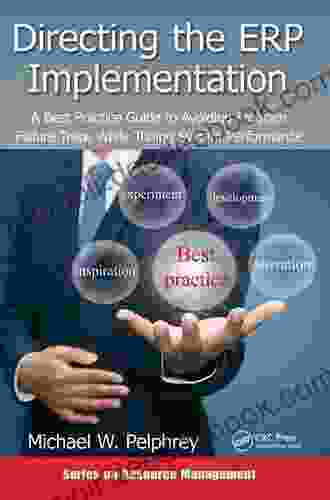Best Practice Guide to Avoiding Program Failure Traps While Tuning System Performance

In the pursuit of optimal system performance, tuning is an indispensable practice. However, it is not without its perils. Uninformed or poorly executed tuning efforts can inadvertently introduce vulnerabilities and instabilities that undermine system reliability and lead to program failures. This guide aims to provide a comprehensive set of best practices to help system administrators and engineers navigate the complexities of system tuning while avoiding common pitfalls.
4.6 out of 5
| Language | : | English |
| File size | : | 16317 KB |
| Screen Reader | : | Supported |
| Print length | : | 380 pages |
Understanding the Risks of System Tuning
Before delving into best practices, it is crucial to recognize the potential consequences of ill-conceived tuning. Failure to appreciate these risks can result in severe system disruptions, data loss, and diminished user experience. Some of the most common risks associated with system tuning include:
- Instability: Improper tuning can disrupt system stability, leading to frequent crashes, hangs, or reboots.
- Performance Degradation: Contrary to its intended purpose, misguided tuning can actually worsen system performance, resulting in slower response times, increased latency, and reduced throughput.
- Security Vulnerabilities: Some tuning practices, such as disabling security features or opening unnecessary ports, can introduce security vulnerabilities that can be exploited by malicious actors.
- Data Corruption: Incorrect tuning can lead to data corruption, resulting in the loss of critical information or system malfunction.
Best Practices for Avoiding Tuning Pitfalls
To mitigate the risks associated with system tuning, it is essential to adhere to a set of well-defined best practices. These practices provide a framework for effective tuning while minimizing the likelihood of introducing system failures.
1. Establish a Baseline
Before making any tuning changes, it is crucial to establish a performance baseline. This involves measuring key performance metrics, such as response time, throughput, and resource utilization, under a controlled environment. The baseline serves as a reference point against which the impact of tuning efforts can be evaluated.
2. Identify Bottlenecks and Performance Issues
To effectively tune a system, it is necessary to identify the root causes of performance issues. This involves analyzing performance data, such as system logs, performance counters, and diagnostic tools, to pinpoint specific areas that are causing bottlenecks or inefficiencies.
3. Plan and Test Changes Incrementally
Avoid making drastic or wholesale tuning changes all at once. Instead, plan and implement changes in small, incremental steps. This allows for thorough testing and evaluation of each change before moving on to the next. Thorough testing is crucial to ensure that tuning efforts do not introduce unintended consequences.
4. Monitor and Analyze Results Continuously
Once tuning changes are implemented, it is essential to monitor system performance continuously and analyze the results. This involves tracking key performance metrics and comparing them to the established baseline. Ongoing monitoring allows for the early detection of any adverse effects and enables timely corrective actions.
5. Document and Audit Changes
It is important to document all tuning changes made to the system. This documentation should include the rationale for the change, the expected impact, and the actual results observed. Regular audits of tuning changes help ensure that changes are well-justified and that their impact is understood.
6. Seek Expert Advice When Necessary
If tuning efforts prove to be ineffective or challenging, do not hesitate to seek guidance from experts. System performance tuning is a complex endeavor that can involve a wide range of factors. Consulting with experienced professionals can provide valuable insights and help avoid costly mistakes.
By adhering to the best practices outlined in this guide, system administrators and engineers can proactively avoid the pitfalls that can lead to program failures while tuning system performance. Establishing a baseline, identifying bottlenecks, making changes incrementally, monitoring results continuously, documenting changes, and seeking expert advice when necessary are essential components of a successful tuning strategy. By following these guidelines, organizations can ensure optimal system performance, minimize the risk of failures, and enhance the overall stability and reliability of their IT infrastructure.
4.6 out of 5
| Language | : | English |
| File size | : | 16317 KB |
| Screen Reader | : | Supported |
| Print length | : | 380 pages |
Do you want to contribute by writing guest posts on this blog?
Please contact us and send us a resume of previous articles that you have written.
 Book
Book Novel
Novel Chapter
Chapter Genre
Genre E-book
E-book Newspaper
Newspaper Sentence
Sentence Bibliography
Bibliography Foreword
Foreword Synopsis
Synopsis Annotation
Annotation Scroll
Scroll Codex
Codex Tome
Tome Library card
Library card Biography
Biography Autobiography
Autobiography Memoir
Memoir Encyclopedia
Encyclopedia Thesaurus
Thesaurus Narrator
Narrator Character
Character Librarian
Librarian Card Catalog
Card Catalog Archives
Archives Study
Study Research
Research Scholarly
Scholarly Lending
Lending Reading Room
Reading Room Rare Books
Rare Books Special Collections
Special Collections Interlibrary
Interlibrary Literacy
Literacy Thesis
Thesis Dissertation
Dissertation Storytelling
Storytelling Reading List
Reading List Book Club
Book Club Theory
Theory Joss Stirling
Joss Stirling Romuald Fonkoua
Romuald Fonkoua Richard Miniter
Richard Miniter Jon Katz
Jon Katz J J Ayton
J J Ayton Richard Gameson
Richard Gameson Gary Galles
Gary Galles Javed Ahmad
Javed Ahmad Peter Pomerantsev
Peter Pomerantsev David A Mckee
David A Mckee Michael W Pelphrey
Michael W Pelphrey John Ericson
John Ericson Guido Bonsaver
Guido Bonsaver H A Rey
H A Rey Kean Birch
Kean Birch Rosalind Miles
Rosalind Miles Juliet Foster
Juliet Foster Tom Sherrington
Tom Sherrington Persia Lawson
Persia Lawson Kehinde Andrews
Kehinde Andrews
Light bulbAdvertise smarter! Our strategic ad space ensures maximum exposure. Reserve your spot today!

 Arthur C. ClarkeNever Before Seen In Ireland: Discover Hidden Gems and Unique Experiences
Arthur C. ClarkeNever Before Seen In Ireland: Discover Hidden Gems and Unique Experiences Simon MitchellFollow ·8.8k
Simon MitchellFollow ·8.8k Camden MitchellFollow ·7.6k
Camden MitchellFollow ·7.6k J.R.R. TolkienFollow ·8.4k
J.R.R. TolkienFollow ·8.4k Brennan BlairFollow ·10k
Brennan BlairFollow ·10k Brett SimmonsFollow ·8.1k
Brett SimmonsFollow ·8.1k Billy PetersonFollow ·3.2k
Billy PetersonFollow ·3.2k Douglas PowellFollow ·16.3k
Douglas PowellFollow ·16.3k Isaac MitchellFollow ·17k
Isaac MitchellFollow ·17k

 Vernon Blair
Vernon BlairHow to Get a Woman to Pay for You: A Comprehensive Guide...
In the modern dating...

 Levi Powell
Levi PowellPrinciples and Theory for Data Mining and Machine...
Data mining and machine learning are two...

 Andrew Bell
Andrew BellMirrors For The Mind: Milestones In Discovery And...
Mirrors have been a part of human history...

 Alec Hayes
Alec HayesDelving into Natural Language Processing with Java and...
Natural Language Processing (NLP) is an...
4.6 out of 5
| Language | : | English |
| File size | : | 16317 KB |
| Screen Reader | : | Supported |
| Print length | : | 380 pages |














